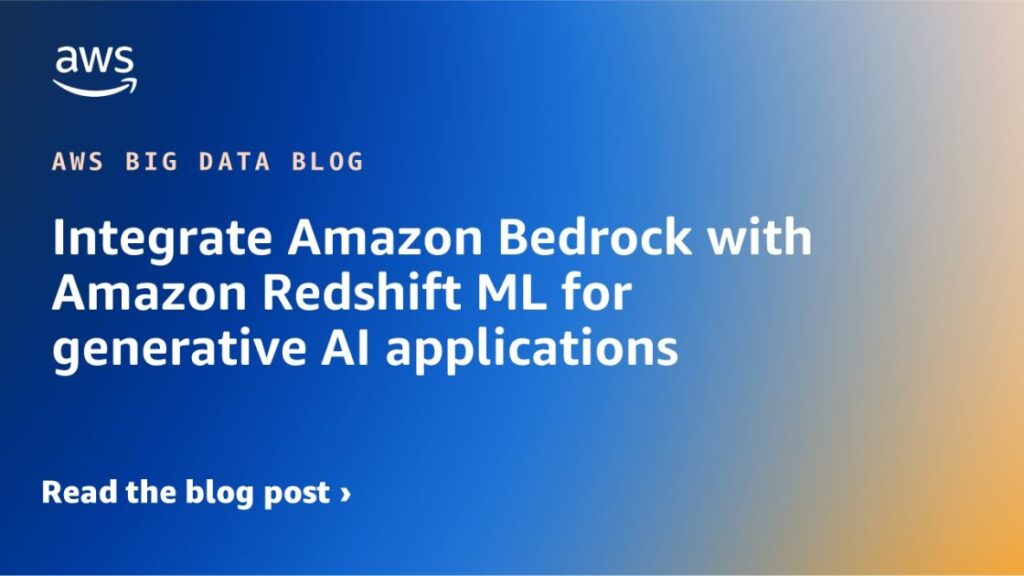Amazon Redshift Shines with New LLM Integration via Bedrock
Amazon Redshift has taken a big leap forward, enhancing its Redshift ML feature with the integration of large language models (LLMs). This exciting update allows users to natively integrate with Amazon Bedrock, creating an avenue for leveraging these powerful AI models seamlessly alongside data in Redshift. If you’ve ever wished to incorporate generative AI into your data analytics, now’s the perfect time to dive in!
Transformative Possibilities with LLMs
With this integration, various generative AI tasks can be accomplished directly on your Redshift data using leading foundation models like Anthropic’s Claude, Amazon Titan, Meta’s Llama 2, and Mistral AI. Whether you need language translation, text summarization, customer classification, or sentiment analysis, you can achieve it with just a simple SQL command. For instance, using the CREATE EXTERNAL MODEL command allows users to reference a text-based model in Amazon Bedrock without requiring additional model training or provisioning.
A Flavorful Example: Creating Personalized Diet Plans
To showcase the potential of this integration, let’s explore a practical example—generating personalized diet plans for patients based on their health conditions and prescribed medications.
Steps Overview
Here’s a glance at the steps involved:
- Load sample patients’ data.
- Prepare prompts for LLM queries.
- Enable LLM access.
- Create a model that references the chosen LLM in Amazon Bedrock.
- Generate personalized diet plans.
Prerequisites
Before diving into the implementation, ensure you have:
- An AWS account.
- An Amazon Redshift Serverless workgroup or data warehouse.
- An AWS Identity and Access Management (IAM) role configured for Redshift ML integration with Amazon Bedrock.
- Necessary permissions to create models in Redshift.
Implementation Steps
Loading Data
First, connect to your Amazon Redshift Query Editor or preferred SQL editor to create a table for patient data. Here’s a quick SQL snippet to get you started:
CREATE TABLE patientsinfo (
pid integer ENCODE az64,
pname varchar(100),
condition character varying(100) ENCODE lzo,
medication character varying(100) ENCODE lzo
);Once your table is set up, load sample data from your S3 bucket using the COPY command.
Preparing Prompts
Next, you need to prepare your prompts by aggregating data about each patient’s conditions and medications. A SQL query can help here, producing a neat output ready for LLM processing.
Enabling Model Access
Navigate to the Amazon Bedrock console to enable access for your chosen LLM model, such as Claude. Simply go to Model Access and grant permissions.
Creating the Model
Back in your SQL editor, create an external model that references the LLM for generating diet plans:
CREATE EXTERNAL MODEL patient_recommendations
FUNCTION patient_recommendations_func
IAM_ROLE '<your_iam_role>'
MODEL_TYPE BEDROCK
SETTINGS (
MODEL_ID 'anthropic.claude-v2',
PROMPT 'Generate personalized diet plan for following patient:');Generating Diet Plans
Now for the fun part! Run the following SQL command to pass your prepared prompt to the function:
SELECT patient_recommendations_func(patient_prompt)
FROM mv_prompts LIMIT 2;You will receive generated diet plans tailored to each patient’s needs. Explore the full responses by adjusting row sizes or exporting your results for easier viewing.
Customization and Additional Options
The integration is highly customizable—control various factors such as inference functions that run only on leader nodes or use different parameters to adjust model randomness and creativity. For example, to receive a precise diet recommendation, adjust the temperature parameter in your queries.
SELECT patient_recommendations_func(patient_prompt, object('temperature', 0.2))
FROM mv_prompts
WHERE pid=101;Manipulating this parameter opens the door to generating more specific or broader recommendations, based on the unique needs of each query.
Considerations and Best Practices
As you work with Redshift ML and Amazon Bedrock, keep in mind the following:
- Throttling exceptions can occur due to runtime limits; however, Redshift attempts to retry requests.
- Consider provisioning throughput for consistent performance.
- Remember that integrated services may incur additional costs based on region and usage.
Wrapping Up
Through this article, we explored how Amazon Redshift has effectively integrated LLM capabilities via Amazon Bedrock, showcasing practical applications that can be tailored to fit a variety of use cases. As you consider diving deeper into generative AI, remember these insights and examples to guide you on your journey.
The AI Buzz Hub team is excited to see where these breakthroughs take us. Want to stay in the loop on all things AI? Subscribe to our newsletter or share this article with your fellow enthusiasts.




